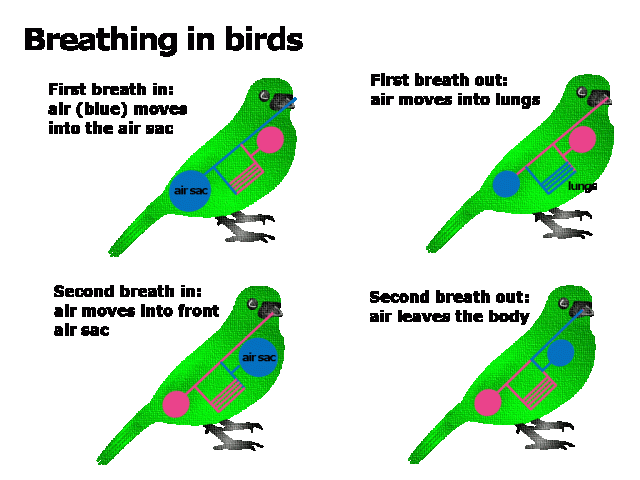Birds breathe quite differently to us. They don’t have a diaphragm and their ribs only move slightly when they breathe in. Instead they use large air sacs like bellows to move air through their lungs. It takes two full breaths for air to move through the lung system of a bird.

It takes two full inhalation-exhalation cycles for a specific volume of air (blue) to pass through bird lungs.
Adapted from Bretz and Schmidt-Nielson, 1972
On the first inhalation (breath in), the air moves down the trachea (windpipe) into air sacs which are located below the lungs (caudal air sacs). The bird then exhales (breathes out) and the air moves into the lung where oxygen can enter the blood and carbon dioxide can leave the blood, ready to be breathed out of the body. Air can actually flow through the tiny sacs where this gas exchange (movement of carbon dioxide and oxygen) happens. On the second inhalation, the air moves through the lung and into air sacs that are located in front of the lungs towards the head of the bird (cranial air sacs). The bird then exhales again and the air leaves the body through the trachea.
The air only ever travels in one direction (unidirectional) from the air sacs behind the lungs, lungs, air sacs in front of the lung and out of the bird. This way of breathing is very different to how mammals (like us!) and amphibians breathe where the air travels in and out of the lungs by the same pathway (bidirectional flow). Birds can breathe in this way because they have air sacs which aren’t used for gas exchange (moving oxygen into the blood and carbon dioxide into the lungs) but act like bellows to push the air along. Air can also flow through some of the tubular parabronchi which is where the gas exchange takes place. Mammals and amphibians do not have parabronchi that air can pass through. Instead, gas exchange happens in the alveoli which are little sacs that air cannot pass through and must leave the way it came it.
So why don’t birds breathe like the rest of us? Unidirection flow of air through the lungs allows birds like barheaded goose to fly over the Himalayas. This efficient lung design allows birds go get enough oxygen at high altitude where the amount (technically the partial pressure) of oxygen in the air is much lower than at sea level. Unidirectional flow also allows birds to sing without seeming to take a breath.

This fantastic pic is provided courtesy of Koshy Koshy. Check out this photo and other great pics on Flickr
